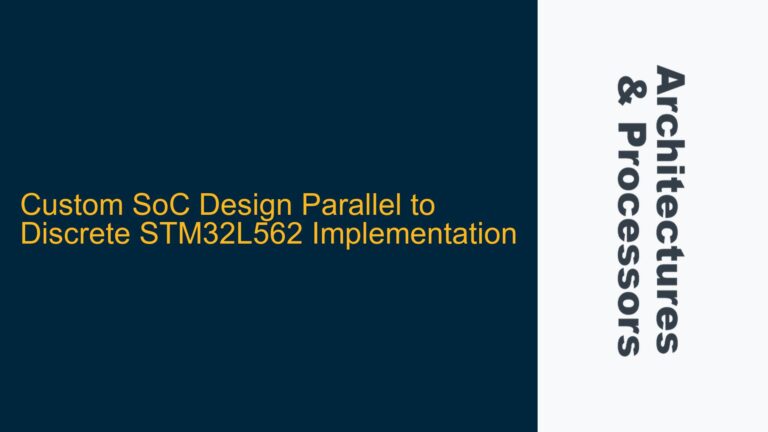ARM GPIO Fail-Safe, Retention, and Core Down Mode Functionality
The ARM Artisan GPIO library provides three critical operational modes for GPIO pins: Fail-Safe, Retention, and Core Down. These modes are essential for ensuring robust and reliable operation in various power and fault scenarios. Understanding the functionality and application of these modes is crucial for designing resilient ARM-based SoCs.
The Fail-Safe mode ensures that the GPIO output is in a high-impedance (Hi-Z) state when the digital supply voltage (DVDD) is powered off. This prevents any unintended current flow or signal contention on the GPIO pin, which could damage external components or cause system instability. The Retention mode retains the GPIO output state when both DVDD and the analog supply voltage (VDD) are powered on, but the retention control signal (RTO) is low. This mode is useful for maintaining the state of GPIO pins during low-power or standby modes. The Core Down mode places the GPIO output in a Hi-Z state when VDD is powered down while DVDD remains active, and the sense signal (SNS) is low. This mode is particularly useful during partial power-down scenarios where the core logic is inactive, but the digital domain remains powered.
The truth table provided in the discussion outlines the behavior of the GPIO cell under these modes. The table specifies the conditions under which each mode is activated and the resulting output state of the GPIO pin. For example, when DVDD is powered off, the GPIO output is forced into a Hi-Z state regardless of the other input signals, ensuring fail-safe operation. Similarly, when both DVDD and VDD are powered on, and RTO is low, the GPIO output retains its previous state, enabling retention functionality.
Fail-Safe Mode: Power Loss Protection and System Safety
The Fail-Safe mode is designed to protect the system and external components from potential damage or malfunction in the event of a power loss or fault condition. When DVDD is powered off, the GPIO output is forced into a Hi-Z state, effectively disconnecting the pin from the external circuit. This prevents any unintended current flow or signal contention that could arise from a floating or undefined GPIO state.
In practical applications, the Fail-Safe mode is critical for systems that interface with external devices or peripherals. For example, in automotive or industrial applications, GPIO pins may be connected to sensors, actuators, or communication interfaces. A sudden loss of power to the digital domain could result in undefined behavior on these interfaces, potentially causing damage to the connected devices or leading to unsafe operating conditions. By ensuring that the GPIO pins enter a Hi-Z state during power loss, the Fail-Safe mode mitigates these risks and enhances system reliability.
The Fail-Safe mode is also important for systems that employ hot-swapping or modular designs. In such systems, individual components or modules may be powered on or off independently, leading to scenarios where the digital domain of one module is powered down while others remain active. The Fail-Safe mode ensures that GPIO pins connected to these modules do not interfere with the operation of other components, maintaining system integrity and preventing potential conflicts.
Retention Mode: State Preservation During Low-Power Operation
The Retention mode is designed to preserve the state of GPIO outputs during low-power or standby modes, where the core logic may be powered down, but the digital domain remains active. This mode is particularly useful in battery-powered or energy-efficient systems, where minimizing power consumption is a key design objective.
When both DVDD and VDD are powered on, and the retention control signal (RTO) is low, the GPIO output retains its previous state. This is achieved by latching the current state of the input signals and maintaining the output state based on these latched values. The Retention mode allows the system to enter low-power states without losing the configuration or state of GPIO pins, enabling quick restoration of normal operation when the system exits standby mode.
In practical applications, the Retention mode is essential for systems that require fast wake-up times or need to maintain critical configurations during low-power operation. For example, in mobile devices or IoT applications, GPIO pins may be used to control peripherals such as displays, sensors, or communication interfaces. By retaining the state of these pins during standby, the system can quickly resume operation without the need for reconfiguration, reducing wake-up latency and improving user experience.
The Retention mode also plays a crucial role in systems that employ dynamic voltage and frequency scaling (DVFS) or other power management techniques. In such systems, the core logic may be powered down or operated at reduced voltage levels to save power, while the digital domain remains active to monitor system conditions or handle low-power tasks. The Retention mode ensures that GPIO pins remain in their configured states during these power transitions, maintaining system functionality and enabling seamless power management.
Core Down Mode: Partial Power-Down Scenarios and GPIO Isolation
The Core Down mode is designed to handle scenarios where the core logic is powered down, but the digital domain remains active. In this mode, the GPIO output is placed in a Hi-Z state when VDD is powered down while DVDD remains active, and the sense signal (SNS) is low. This mode is particularly useful in systems that employ partial power-down strategies, where specific components or domains are powered down to save energy while others remain operational.
In practical applications, the Core Down mode is essential for systems that require selective power management or have complex power domain hierarchies. For example, in multi-core processors or heterogeneous computing platforms, individual cores or processing units may be powered down to reduce power consumption, while other components such as memory controllers or communication interfaces remain active. The Core Down mode ensures that GPIO pins connected to powered-down cores are isolated from the rest of the system, preventing any unintended interactions or conflicts.
The Core Down mode also plays a critical role in systems that employ power gating or clock gating techniques. In such systems, specific blocks or domains may be powered down or clock-gated to reduce dynamic power consumption. The Core Down mode ensures that GPIO pins associated with these blocks are properly isolated, preventing any leakage currents or signal contention that could arise from partially powered-down domains.
Troubleshooting GPIO Mode Implementation and Verification
Implementing and verifying the Fail-Safe, Retention, and Core Down modes in an ARM-based SoC requires careful consideration of the design and verification strategies. The following steps outline a systematic approach to troubleshooting and ensuring the correct implementation of these modes.
Step 1: Validate Power Domain Configuration and Isolation
The first step in troubleshooting GPIO mode implementation is to validate the power domain configuration and isolation. Ensure that the power domains for DVDD and VDD are correctly defined and that the isolation cells are properly instantiated and configured. Verify that the power domain crossings are correctly handled and that the isolation signals (e.g., RTO, SNS) are properly generated and controlled.
Step 2: Verify GPIO Cell Configuration and Signal Routing
Next, verify the configuration and signal routing of the GPIO cells. Ensure that the GPIO cells are correctly instantiated and configured to support the Fail-Safe, Retention, and Core Down modes. Verify that the input signals (e.g., OE, DS0, DS1, SR, PE, PS, A) are correctly routed and that the output signals (e.g., PAD) are properly connected to the external pins.
Step 3: Simulate Power-Up and Power-Down Sequences
Simulate the power-up and power-down sequences to verify the behavior of the GPIO pins under different power conditions. Use simulation environments such as SystemVerilog and UVM to create testbenches that model the power domains and simulate the power-up and power-down sequences. Verify that the GPIO pins enter the correct state (Hi-Z, Retained, or Core Down) under the specified conditions.
Step 4: Validate Mode Transitions and Timing
Validate the transitions between the different GPIO modes and ensure that the timing requirements are met. Verify that the GPIO pins transition smoothly between the Fail-Safe, Retention, and Core Down modes without any glitches or unintended behavior. Use timing analysis tools to verify that the setup and hold times for the control signals (e.g., RTO, SNS) are met and that the GPIO pins respond correctly to changes in the control signals.
Step 5: Perform Corner Case Analysis and Stress Testing
Perform corner case analysis and stress testing to identify potential issues and ensure robust operation under extreme conditions. Test the GPIO pins under various power supply voltages, temperature ranges, and load conditions to verify that the Fail-Safe, Retention, and Core Down modes operate correctly. Use fault injection techniques to simulate power loss or fault conditions and verify that the GPIO pins enter the correct state.
Step 6: Review and Update Synthesis Constraints
Review and update the synthesis constraints to ensure that the GPIO cells are correctly synthesized and optimized for the target technology. Verify that the synthesis constraints include the necessary timing and power domain information and that the GPIO cells are correctly placed and routed in the final layout. Use static timing analysis (STA) tools to verify that the timing requirements are met and that the GPIO pins operate correctly under all conditions.
Step 7: Perform System-Level Verification and Validation
Finally, perform system-level verification and validation to ensure that the GPIO pins operate correctly in the context of the overall system. Use system-level simulation environments to verify that the GPIO pins interact correctly with other system components and that the Fail-Safe, Retention, and Core Down modes are correctly implemented and verified. Perform hardware validation on prototype boards to verify that the GPIO pins operate correctly under real-world conditions.
By following these steps, you can ensure the correct implementation and verification of the Fail-Safe, Retention, and Core Down modes in your ARM-based SoC design. This systematic approach will help you identify and resolve potential issues, ensuring robust and reliable operation of the GPIO pins under various power and fault conditions.






